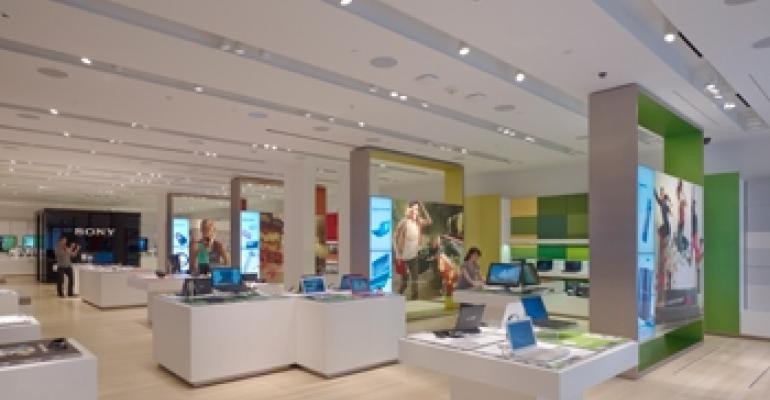In an effort to create a more interactive customer experience, Sony Electronics has unveiled a new store concept under the Sony brand name. The new store opened on Apr. 1 at Westfield Century City, an 878,155-square-foot open-air retail center in Los Angeles.
Following a lead set by the success of Apple Stores, hard goods retailers increasingly have been allowing customers to play with and test new products within their stores. That’s the approach that Sony Electronics adapted with its new concept.
The 4,200-square-foot store at Westfield Century City features movable interior walls and a modular color scheme that can highlight products. Meanwhile, merchandise is displayed on tables in open spaces, allowing customers to interact with the latest gadgets. Today, customers at the store can test Sony’s network services including Music Unlimited and Video on Demand, its network-connected products, its cameras and related gadgets.

At any given time, there are about a dozen Sony technology experts on hand to encourage shoppers to try the products and explain new features to them, says Phillip St. Pierre, general manager of Westfield Century City. In addition, the new store features a RayModeler, a 360-degree display prototype that projects 3D images of Sony products.
“Everything is very open, very accessible, it really begs you to pick things up and explore,” he notes. “And the staff helps you understand all those scary little features you might be afraid to touch on your own.”
Most of the existing Sony stores in the U.S. feature more traditional displays, with products lying on racks, largely out of shoppers’ reach, St. Pierre adds. Existing stores are also slightly smaller than the new concept, around 3,500 square feet.
The overall look of the new store is bright and airy, with clean lines. Japanese architecture firm Klein Dytham designed the space, which took about two months to build.
“The consumer touch point is a very important part of Sony’s strategy and the new Sony concept store embodies our commitment to the ultimate consumer experience and serves as a blueprint for future stores in the U.S. and across the world,” says Elizabeth Boukis, a spokesperson for Sony Electronics. “The new Sony store in Los Angeles features an energetic, modern environment in both design and architecture.”
The company chose Los Angeles for the launch of the new concept because of its reputation as a capital of the movie and music industries, according to Boukis. In addition, the median age within Westfield Century City’s trade area, which is 26, also played a role in the decision. Sony Electronics expects that the new concept will hold special appeal for those in the younger demographic.
In addition, household incomes in the area average $101,476 a year. Approximately 11.9 million people visit Westfield Century City on an annual basis. The property features an AMC movie theater, a Bloomingdale’s, a Louis Vuitton and a Tiffany & Co. store, among other venues.
“Research shows that the customer base in Century City is very savvy, and open to having cutting-edge technologies [as] part of their lives,” Boukis says.
Previously, Sony Electronics already operated 30 full-line and 16 factory outlet stores in the United States. In 2010, however, the company launched an initiative to re-brand all of its stores, previously run under the name Sony Style, starting with stores in its home market of Japan.
The new concept store is part of that re-branding initiative and elements of its design will likely be incorporated into some of the existing Sony stores stateside. The company will also likely open more new stores throughout the country—the Westfield Group, owner of Westfield Century City, expects to sign new leases with Sony going forward.
For the moment, however, the company is keeping mum on which of its stores might be slated for a redesign or how many new locations might be in the works.


